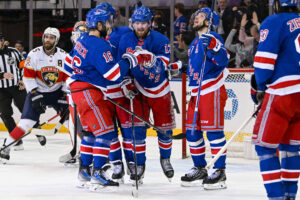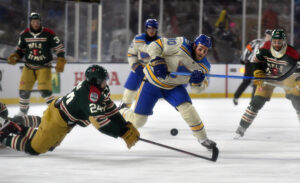General managers from around the league have discussed – among other things – changes to NHL overtime rules. There were a couple of suggestions that leaked out and, well, they don’t inspire confidence. They say they want exciting play and spit out retread ideas. We at Last Word can and will do better than that!
Make NHL Overtime the NHL’s Overtime
The biggest problem, or “problem” is that coaches have figured out the best strategy. Barry Trotz had worked out the ideal solution before the first overtime: keep the puck. It’s not exactly hard, but most teams at least kept up the appearance of chaos, deliberately or otherwise.
In a nutshell, if you win possession, make the other team chase you until they are out of position. With that much empty space, it’s hard to stop even modestly accurate passes. And the puck always moves faster than any player. If a shot isn’t available, circle back and regroup. Repeat as necessary.
The ideas that have come out of the general managers’ meeting are ones we’ve all heard before. According to Pierre LeBruin here’s who came up with what.
General Manager’s Solutions
The Devils Tom Fitzgerald thinks overtime should be longer. Which, frankly, doesn’t actually solve anything other than make star players skate more. Given the interest in time management for star players and resistance from the NHLPA, this isn’t happening. But at least Fitzgerald was willing to put his name on it.
One of two anonymous concepts is to hand over the puck if it leaves the attacking zone. That is going to be a judgment call by referees if it’s sent out by a bad pass or smacked off a stick. And we know how fans feel about the refs making judgment calls. You can see another excuse for whistles and calls to the head office in OT. Not what we want, not what anyone wants.
The other idea was adding a shot clock, but from when? And where do they put that clock? Sometimes the change of possession is ambiguous at best, and yeah, there we go back to the head office in Toronto. Gotta see when – and if – the opponent touched the puck half a second before the clock started, for accuracy’s sake! Both of these are borrowed straight from basketball, and if we wanted to watch that we would. There was also some mention of letting anyone on the team take penalty shots, which happens in European shootouts. One or two players take all the shots. But then where do you get glorious moments like this? Our eyes are rolling more than a Yahtzee cup. Let’s get weird.
Actually Interesting NHL Overtime Solutions
Disposable Heroes
Levi Pike brought up one change brought in from no one else. That glorious Marek Malik shootout goal only happened because teams aren’t allowed to use the same skater twice. Let’s add that to overtime!
Not just individual players, but entire trios. Coaches hand in their lines before overtime starts, and once you use them you can’t use them again. As he put it: “set your lines beforehand, and once they come off can’t come back on.”
That’s a coaching challenge, indeed! Do you put your best attackers out there right away? Or do you anticipate your opponents doing that and hope your second-best guys can get the job done? Or at least hold off their best until you can get the advantage? Even better – all three players have to change within five seconds.
That also forces dump-ins so you can change lines safely without mixing them and taking a penalty. Unless, of course, you want to try keeping your best out there waiting for their line change. Can you score with tired players before the cavalry arrives? Because if you don’t, they have fresh legs AND the puck…
Possession? I’LL Give You Possession!
If the biggest fear of GMs is that one team will play a simple puck-possession game, fine. We’ll give the other team a puck, too! Now, this means the teams will be back up to five-on-five hockey or the extra puck will just end up ignored in a corner somewhere. Since we don’t want that to happen, let’s have one of the linesmen drop a puck at centre ice after a minute.
Line changes are going to get really interesting, we guarantee it! Instead of a forward covering the point, he suddenly bursts out, and after the extra puck at centre. Does a defender go with him, or do they try to take advantage of his absence? You get a five-second power play – longer if your goalie stops him – and he gets a breakaway. Choose wisely!
Of course, if players are in the neutral zone, that becomes an interesting battle of its own. If one team gets both pucks, what do they do with them? Ignore one? Shoot it back down the ice? Keep it as a threat while taking a player out of commission? Maybe some enlightened coach has a play drawn up for exactly that.
Some rules would need to be modified, of course. The second puck can’t cause an offsides, for instance. If the goalie holds the puck for a faceoff, that puck gets dropped in ten seconds come hell or high water. Oh, you went for a line change? Too bad! Your players are all busy with the other puck in the attacking zone? This lone forward wins the faceoff, then, and is going one-on-one with your goalie. Again.
Would These NHL Overtime Solutions Work?
The first would take some getting used to. If identical twins come back into the league, it could be tricky to keep track on the ice. If Henrik Sedin got waved out of the circle, half the time he’d circle around with Daniel Sedin and take the faceoff anyway. But the cameras would catch players coming on and off the ice.
It would be difficult, but the league could make it work. As for the second, not a chance. That would be utter chaos on the ice, and while tremendous fun for the fans completely bewildering to referee. There would need to be split cameras for the home viewer, designated zones for refs and linesmen, and the ability to ignore whistles coming from the other end of the ice. Alas, we may be stuck with the bland, already done in other leagues solutions to overtime. Pity.
main photo: Rick Osentoski-USA TODAY Sports






